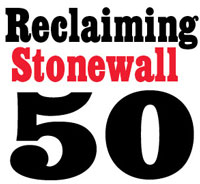 Earlier this year in April, Nigel Shelby, a 15-year-old African American gay kid from Huntsville, Alabama, killed himself. Shelby was out at school and, as a result, was bullied relentlessly. The routineness of antiqueer bigotry was exemplified by a local law enforcement officer who mocked Shelby’s death in a Facebook post. He wrote that “society should not except [sic] this behavior.”
Earlier this year in April, Nigel Shelby, a 15-year-old African American gay kid from Huntsville, Alabama, killed himself. Shelby was out at school and, as a result, was bullied relentlessly. The routineness of antiqueer bigotry was exemplified by a local law enforcement officer who mocked Shelby’s death in a Facebook post. He wrote that “society should not except [sic] this behavior.”
Almost simultaneously, Shelby’s tragic death was commemorated publicly by elected officials like Senator Cory Booker and his funeral was paid for by celebrities including Janelle Monáe, Ludacris, Gabrielle Union, and Dwyane Wade, among others.
The contrasting realities provoked in the life and death of Nigel Shelby exemplify the contested and complicated legacy of the Stonewall rebellion, 50 years on. It is indisputable that Stonewall forever widened the space within which queer identity could exist in the open. The emergence of a queer movement for “Gay liberation!” helped to create the conditions for “coming out”—a precondition for actual liberation.
Of course, queer people had always existed in varying degrees of openness depending on location, among other factors. But the emergence of the Stonewall rebellion in the context of the “rights revolution” of the 1960s, and the eruption of social movements among the oppressed and dispossessed in the United States, situated the political demands of queers within the other struggles of the oppressed, further legitimizing queer existence.
The trajectory of the incipient gay movement in the 1970s was influenced by many of the same dynamics that shifted the priorities of the period’s other movements. A deep trench developed between those whose resources and class status carved out a space within the existing social and political hierarchy and those who remained on the outside looking in. This was particularly true for queers of color, who were (and largely remain) disproportionately within the ranks of the working class and whose meager resources could not buy them protections from the intransigence of structural homophobia. The public face of queer militancy at the heart of the Stonewall uprising was transposed with a white, middle class respectability that sought to mimic the straight establishment but with cosmetically “gay” characteristics.
This does not discount the decades-long struggle for legal rights and social visibility intended to mitigate the vulnerabilities created by the closet and the isolation of living in a punishing heteronormative society. But after 50 years and many different iterations of struggle, “gay liberation” has been supplanted by the nebulous call for “gay pride.”
The result has been to confuse forms of visibility—whether it be Pride parades, rainbow flags, or queer celebrity in popular culture—for actual rights and civic equality. As is always the case, the absence of legal protections leads to social differentiation that makes those outside the protection of law vulnerable to social stigma, marginalization, and ultimately ostracization and even physical attack.
This is, at least, part of the way that we can understand the vulnerabilities of young LGBTQ people for whom suicide remains a constant threat. LGBTQ kids are five times more likely to attempt suicide in comparison to their straight peers. Seventy-four percent of queer youth report that they “do not feel safe in school.” Thirty-four percent of queer kids are bullied and 40 percent consider suicide. The attacks on queer kids at school have been hastened by the bigotry of the Trump administration. When Secretary of Education Betsy DeVos was asked this past March if she was personally opposed to discrimination against LGBTQ students, she refused to answer the question.
It is true that the LGBTQ movement secured the legal right to civil marriage in 2013, but in a society organized around the logic of the nuclear family—and which remains deeply invested in normative and violent conceptions of masculinity and the subordination of women—the attacks on working class and poor LGBTQ people remain intact.
Indeed, for all of the orchestrated celebrations of gay pride every June, the persistence of homophobia and the structures of legal discrimination dominate the lives of marginalized queers. Twenty-six US states offer no legal protections from employment or housing discrimination against at LGBTQ people. And all of this underestimates the degree of open and vicious vitriol—legal and social—that is directed at transgender people throughout this country.
Progress is not dictated simply by the passage of time; for it to mean anything, it must resemble some semblance of freedom, democracy, and justice. For millions of LGBTQ in the United States, this struggle for liberation continues well into the 21st century.


